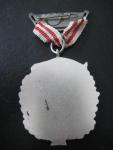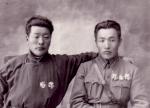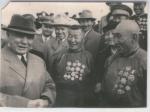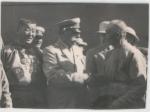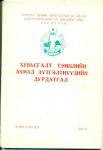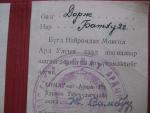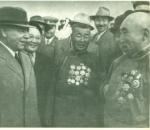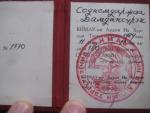-
Posts
3,879 -
Joined
-
Last visited
-
Days Won
13
Content Type
Profiles
Forums
Blogs
Gallery
Events
Store
Everything posted by Bob
-
-

Mongolia Hero and labour Hero of the Mongolian People's republic
Bob replied to Vatjan's topic in People's Republic Mongolia
Some additional data points: * Serial numbers >400 were awarded since 2000 * The Gold Soyombo Medal with a serial number 427 was awarded to General Tsede-Ish in 2006. He is the last entry in the blue sky bible (and this confirms that the number code at beginning of entry is NOT corresponding with the Soyombo serial nr!) * Also, I have a document to a Soyombo (posted somewhere here or on another site), it's awarded to Putsagiin Oyun, but the serial number (no surprise) has been altered and probably is more in the rage of 270-280... as the nr (424 if not mistaken) in the booklet could never have been awarded on the unaltered date of 1986 in the booklet - her profile then appears to be on page 101 of the blue sky bible (321.263) -
http://gmic.co.uk/index.php?showtopic=36164&st=60&gopid=430127& Some more pics on Sodnomdarjaa. Also, on research, I am awaiting delivery of a series of books (3 books) with biographies of all of the (400 or so?) Mongolian partisans. Apparently book series similar to the Soviet books on heros of the soviet union and the other book on the caveliers of the order of glory. Slowly but surely :cheers:
-

Soviet 1920's order of the red banner
Bob replied to Bob's topic in USSR: Soviet Orders, Medals & Decorations
Looking again at this pic, it seems that Sodnomdarjaa had an "old style" Mongolian red banner... and then years later, he has a "new style" one. Confirmation that (similar to Soviet practice) there was a "return/replace" policy for old style orders? -

Soviet 1920's order of the red banner
Bob replied to Bob's topic in USSR: Soviet Orders, Medals & Decorations
Group photo: Sodnomdarjaa with a group of officials and herders. Names of most people unknown, with the exception of the General sitting next to Sodnomdarjaa (on his left). The general is Lt. General Janchiv who was the Minister of the Military and Public Security Ministry mid 1950s. Sodnomdarjaa is second row, 3rd person from the left -

Soviet 1920's order of the red banner
Bob replied to Bob's topic in USSR: Soviet Orders, Medals & Decorations
More later, incl a potential breakthrough in research on the 400-500 (?) partisans of the mongolian revolution (in process of obtaining source with bios of all partisans... those with a named doc will be lucky i think!) -

Soviet 1920's order of the red banner
Bob replied to Bob's topic in USSR: Soviet Orders, Medals & Decorations
And here another pic with Voroshilov... AND with broad smiling Colonel General Lhagvasuren in his parade uniform in top right hand corner! -

Soviet 1920's order of the red banner
Bob replied to Bob's topic in USSR: Soviet Orders, Medals & Decorations
And here with Marshal of the Soviet Union Budyonii. One of the first 5 Marshals and, aside from Voroshilov who signed the red banner doc, the only one of the 5 not purged in the 1930's. Sodnomdarjaa picked his "friends" well! http://en.wikipedia.org/wiki/Semyon_Budyonny -

Soviet 1920's order of the red banner
Bob replied to Bob's topic in USSR: Soviet Orders, Medals & Decorations
-
Any chance to get a bigger scan so helpful people can translate for our pleasure/learning? Thx
-
Book “Memoirs of the Veterans of Revolution and Labor”, Choibalsan, 1981. Published on the occasion of the 60th anniversary of People’s Revolution and the 50th year anniversary of Dornod (Eastern) province Compiled by O.October Edited by S. Byambajav Pages 21-25. The Communist inspired by Labor The beginning… Batkhuyag was bereaved from his parents at the age of nine. Since then he used to work (tending the livestock, leading the caravans, etc) for wealthier families to meet the ends. At the age of 19, Batkhuyag was drafted to the Mongolian People’s Revolutionary Army. As a conscript, Batkhuyag was exposed to the teachings of the Communism and received the primary education. Serving for the people In 1945, Batkhuyag was appointed as the head of the bagh (smallest administrative unit of Mongolia). The 1940s were the years of the Great Patriotic War against the fascist invaders in the Soviet Union. The Mongolian People’s Republic, as the closest ally of the USSR, exerted all efforts to help the Soviet people in winning the war. “All for the front” campaign lasted until the end of the war in Mongolia. Therefore, during the war years, Batkhuyag was responsible for collecting the gifts for the Red Army, purchasing the horses for the front from the herders of his bagh and helping the government to advance animal husbandry in Dornod province. To this end, the bagh leaders had to closely work with the herders despite of the lack of funds and transportation. The bagh leader was paid a 40 Tugrugs (Mongolian National currency) salary each month and the other activists of the bagh worked voluntarily. At that time, the livestock, the basis of the national economy, was still in hands of the private farmers. Therefore, the bagh leaders were also responsible for fulfilling the quotas for meat, milk, dairy products, wool, hide and other animal raw materials. At the same time, the bagh leaders spent most of their time in arranging the horses for the public transportation and provision of the goods to the herders. Establishing the Agricultural Collective Farms Dorjiin Batkhuyag actively participated in the implementation of the party and government’s policies on strengthening the agricultural collective farms, publicizing the advantages of the socialist collective farms to the herders and improving the working and living conditions of the collective farmers. In February 1956, when Batkhuyag was managing the first cooperative of the Tsagaan-Ovoo county, the first Chairman of the Party Committee of Dornod aimag informed him on the Party’s decision to appoint him as the head of the “Galuut” collective farm. He further noted that the decision of the party was based on the request of the herders. Since then, Dorjiin Batkhuyag is successfully leading the “Galuut” collective farm for the 25th year. The first collective farm There were a total of 38 households of the collective farm. The population of the farm was 144 people with only 56 of them being the members of the farm. A total of 4016 heads of livestock were registered with the farm and the farm owned one wooden house and four gers (Mongolian national dwelling). The property of the farm was estimated at 200.000 Tugrugs. The acting head of the collective farm comrade D. Badam explained to Batkhuyag during the handover of the farm “the farm consistently failed in meeting the quotas for animal products for the last several years. The finances of the farm are in desperate situation. The farm has no funds to pay the wages of the farmers. The farm has only 153 Tugrugs in cash and over 20.000 Tugrugs debt to other organizations”. Definitely, it was not pleasant news for incoming head of the farm. There were also other problems faced by the collective farmers. This included conflicts between the collective farm members and private herders on the use of the water wells and the pastures. Despite of the problems, in few years Batkhuyag succeeded in demonstrating the advantages of the collective farming over the private herding. Communist Batkhuyag proved to be an excellent organizer of the collective efforts and gained respect and the trust of the herders. Twenty-five years with the collective farmers Out of the 40 year history of the Mongolian collective farming, the last 20 years are the years of prosperity of the economic and cultural aspects of the collective farms. As of now, the “Galuut” collective farm has 130000 heads of livestock, 16 million Tugrug properties and an annual profit of 7 million Tugrugs. On the occasion of the 10th anniversary of victory of collectivization movement in the Mongolian People’s Republic, the “Galuut” farm was awarded the Order of the Red Banner of Labor Valor for its labor accomplishments. The Secretary of the MPRP committee of the “Galuut” collective farm comrade V. Tsedendorj was bestowed the title of the Hero of Labor of the MPR. At the same time, many other farmers of the farm were awarded the orders and medals on this occasion which is an example of the excellent leadership of the senior communist comrade Batkhuyag. The role of the MPRP Comrade Batkhuyag considers the event of joining the membership of the Mongolian People’s Revolutionary Party as one of the unforgettable and important landmarks of his life. His loyalty and commitment to the objectives and principles of the party and the stretching of his mind and physical abilities to fulfill the task of the party have eventually brought today’s labor fame and respect. Comrade Batkhuyag said “the twenty-five years of hard work for strengthening the collective farming and improving the working and living conditions of the collective farmers have yielded the tangible results. There were days of exhausting work pressure with no food or sleep for the benefit of the collective farm and numerous problems that made my life difficult. Yet I have never given up and thanks to this; we have succeeded. I have never been officially schooled in my life. Therefore it was not easy for me to lead and manage such a large farm. I always looked at problems as opportunities and after accomplishing the task, I have enjoyed the feeling of accomplishment”. The party forged my attitude and instilled the love for my work. There is a saying “One who follows the Sun will never get cold; One who follows the Party will never fail”. To younger generations Thanks to the wise leadership of our loved Party and humane government, anybody in our country regardless of age is living in happiness. This year is the year of the 60th anniversary of the people’s revolution and it is equally pleasant to meet this historic anniversary with the labor achievements. However, everyone has to work creatively and fruitfully in the future so that we contribute to the acceleration of victory of socialism and communism in Mongolia. This goal should dominate the hearts and minds of every citizen of our nation.
-
More on Batkhuyag - and all triggered by a lone award document! Cover of book: “Memoirs of the Veterans of Revolution and Labor”, Choibalsan, 1981. Published on the occasion of the 60th anniversary of People’s Revolution and the 50th year anniversary of Dornod (Eastern) province
-
-
I suspect we're going to see that these kind of "agricultural" SB awardings may be the Mongolian equivalent of the Soviet "long service" awardings. In any case, the power of research is that these pieces of history which would otherwise be long forgotten can still be shared and appreciated. Here's more (and more to come later...) on Batkhuyag. It comes from a book published in 1981 on the 50th anniversary of Dornod province. The book is titled "Memoirs of the Veterans of Revolution and Labor". "Dorjiin Batkhuyag was born in Khalkha Gol county of Dornod province in 1921. He became the member of the Mongolian People’s Revolutionary Party in 1945. He served for the Mongolian People’s Revolutionary army from 1940-1942. Comrade Batkhuyag devoted 40 years of his life to serving the country including 25 years as the Head of the “Galuut” collective farm of Tsagaan – Ovoo county. Comrade Batkhuyag was awarded the Order of Sukhbaatar, the Order of the Red Banner of Labor Valor, the Order of the Polar Star and medals for his labor achievements. He was chosen as the delegate to 14th and 15th Congress of the Central Union of Cooperatives of the Mongolian People’s Republic, 3rd, 4th and 5th Congress of the Agriculturalists and 17th Congress of the Mongolian People’s Revolutionary Party."
-
On 695, I only have the booklet not the actual SB.
-
Just in, some preliminary research on SB 695 "In December 1960, the new “Galuut” collective farm was founded in Tsagaan Ovoo county of Dornod province. The Chairman of the Tsagaan-Ovoo county comrade Dorjiin Batkhuyag was appointed to head the “Galuut” cooperative farm. Within a few years, Comrade Batkhuyag managed to strengthen the new cooperative farm and transform the farm into one of the best farms of the Mongolian People’s Republic. The farm showed high results in agricultural production for two decades. At the same time, conditions of the agricultural workers and farmers of the cooperative have been significantly improved. For outstanding agricultural productions, the “Galuut” cooperative was awarded the Order of the Red Banner of Labor Valor by the Decree # 272 of the Presidium of the People’s Great Khural in December 1969. For excellent leadership and management of the farm, the Chairman of the farm comrade Dorjiin Batkhuyag was awarded the Order of Sukhbaatar on December 18, 1969." Excerpt from the book on History of Dornod province of Mongolia. Ulaanbaatar. 1993. ...and also: "2117.14. Dorjiin Batkhuyag was born in 1921 at Khalkha Gol county of Dornod aimag. He was bestowed the title of the Merited Collective Farmer by the Decree of the Decree # 182 of the Presidium of the People’s Great Khural on June 26, 1981 when he was heading the “Galuut” collective farm in Tsagaan Ovoo county of Dornod province. He was distinguished for his many years of excellent management of the collective farms in Dornod province and especially for strengthening the agricultural and financial capacity of the “Galuut” collective farm in Tsagaan Ovoo county. He was also respected by the workers for his care for the workers and efforts to improve their living conditions. " That last bit is from the blue book of bio's. He's in there as he won a merit title. Page 668.
-

Soviet 1920's order of the red banner
Bob replied to Bob's topic in USSR: Soviet Orders, Medals & Decorations
Voroshilov during his visit to Mongolia in 1957. He is with Tsedenbal and they are meeting with Sodomdarjaa and Togtokh. -
More on Lt. Colonel Sharavjamts Shadavtsoodol: Sharavjamts Shadavtsoodol was born in Tugrug village of Uvurkhangai province on March 1, 1921. In 1939: Private of Mongolian People’s Revolutionary Army. 1939-1940: Weapons maintenance course at the Artillery intermediate school in Tambov town, the Soviet Union. 1940-1943: Weapons repair officer at the Motorized brigade of the Mongolian People’s Revolutionary Army. 1943-1945: Studied at Artillery intermediate school in Tambov town, the Soviet Union. 1945-1948: Commander of the Artillery repair workshop at the Motorized brigade of the Mongolian People’s Revolutionary Army. 1948-1956: Commander of the Artillery repair workshop at the Tank regiment of the Mongolian People’s Revolutionary Army. 1956-1957: Commander of Artillery repair workshop of the Mongolian People’s Revolutionary Army. 1957-1958: Commander of the platoon of the motorized rifle battalion #1 (In 1957, the Army was reformed and thousands of the officers were transferred to civil organizations) 1958-1961: Shooting trainer at Voluntary Society to assist the People’s Army (Mongolian DOSAAF). 1961-1964: Senior shooting trainer at Voluntary Society to assist the People’s Army (Mongolian DOSAAF). 1964-1973: Trainer in shooting at the General Military School. 1973: Discharged from the active military service.
-
Rereading the roles some of these SB recipients had: " "Leader of the hay preparation brigade of “Salhyt” fodder preparation station of Sukhbaatar aimag" Hay preparation bridage - that's just brilliant :cheers:
-

Prins Dschero Khan - US special forces?
Bob replied to Herr General's topic in United States of America
From the first video link with the documentary and some online sources I got the impression that he was affiliated with various foreign military units in a training/support role but was never formally a member. E.g. various photographs shown in the documentary do give the impression he was in Korea, Vietnam, etc. And that he is just a bit liberal (but probably without ill intent) in wearing various unit badges etc. The guys story is pretty amazing (again, even if some of it is over the top) -

Prins Dschero Khan - US special forces?
Bob replied to Herr General's topic in United States of America
I'm not going to rush to judgement on this. The story is an interesting one, he was born in mongolia (supposedly) and his parents were killed by the chines, he fled (helped by a monk) to indonesia as a young boy and when the japanese arrived there he fled again eventually winding up in the netherlands. The documentary shows him being received by the mongolian president (!) a few years ago... and there's quite some martial arts footage in the documentary as well. Whatever the truth, it sounds like an interesting story. -

Prins Dschero Khan - US special forces?
Bob replied to Herr General's topic in United States of America
around 42 minutes he's at a dutch korea veterans meeting... one of them says they were in korea together, he says that the other vet was awarded a bronze star -

Prins Dschero Khan - US special forces?
Bob replied to Herr General's topic in United States of America
http://fr.truveo.com/het-bloed-van-genghis-khan-21102007/id/3598738166 A dutch language documentary... which certainly appears to indicate his story may be legit -
http://gmic.co.uk/index.php?showtopic=4230&st=360&gopid=424933& Yes, it is (on a very limited and "fragile" basis) possible to do research... BUT, it appears that we may have all underestimated the importance of award documents vs. the actual awards due to serial numbers not easily being available in the places where research is found. Treading gently in this area - i don't want anything to backfire... LOT's more to come (slowly but surely)
-
Forgot the scan... And, here's something interesting that found its way to me... and which may also help others (assuming SB's were awarded in same order as names below). "The Decree of the Presidium of the People’s Great Khural of the Mongolian People’s Republic 11 November 1989 Number 180 Ulaanbaatar On awarding some people with the orders and medals The Presidium of the People’s Great Khural of the Mongolian People’s Republic decrees: To award the following individuals with the orders and medals of the Mongolian People’s Republic for long, fruitful and active labor in the agricultural sector of the country. The Order of Sukhbaatar: 1. Balbaryn Gomboragchaa Head of the “New Life” collective farm of Chuluut soum of Arhangai province 2. Sanatbain Hadan Herder of the Bayannuur farm in Bayan-Ulgii province 3. Baasandambyn Samdandorj Driver of the Harvesting machine of “Sansar” fodder preparation station in Bulgan province 4. Dendeviin Ulziihutag Herder of the “Tuya” collective farm in Dalanjargalan soum of Dornogobi province 5. Maamanhugiin Baldorj Herder of the “Jargalant” collective farm in Tsogt-Ovoo soum of Umnugobi aimag 6. Gendengiin Monhooroi General accountant of the “Sukhbaatar’s path” collective farm in Uulbayan soum of Sukhbaatar aimag 7. Samdangiin Bud Leader of the hay preparation brigade of “Salhyt” fodder preparation station of Sukhbaatar aimag 8. Gandangiin Namjildorj Director of the plant under the collective farms in Tuv aimag 9. Godnomdarjaagiin Damdinsuren Director of the “Bayantsogt” farm in Tuv aimag 10. Peljidiin Boloosh Mechanic of the “Jargalant” farm in Tuv aimag 11. Ochiryn Dashdendev Director of the “Youth” farm in Tuv aimag 12. Khorloogiin Tsendbayar Head of Crop section of the fodder prepration station in Erdenesant soum of Tuv aimag 13. Rentsengiin Uhnaa Herder of the “Davshilt” collectiver farm in Zuunhangai soum of Uvs aimag 14. Tangadyn Dalantai Herder of the “Tsog” collective farm in Umnugobi soum of Uvs aimag 15. Luvsannyamyn Byambadorj Herder of the “Soyol” collective farm in Buyant soum of Khovd aimag Chairman of the Presidium of People’s Great Khural (signed) J. Batmumkh Secretary of the Presidium of People’s Great Khural (signed) Ts. Gotov"


